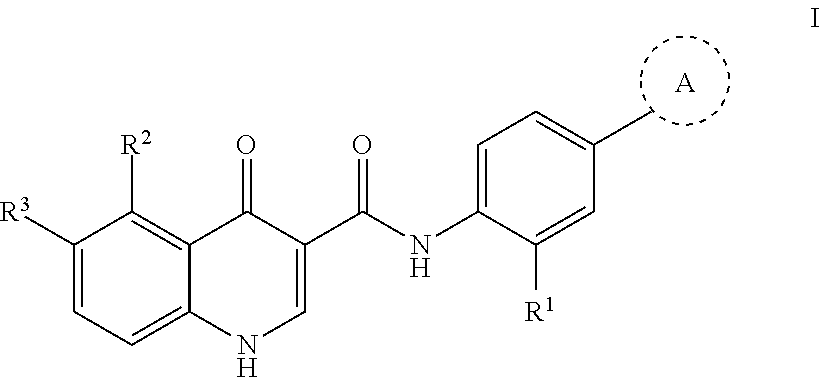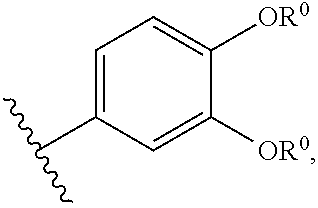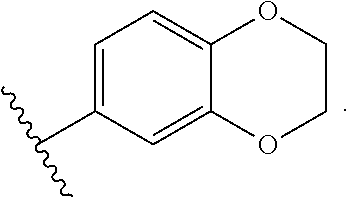Modulators of Cystic Fibrosis Transmembrane Conductance Regulator
a technology of transmembrane conductance and cystic fibrosis, which is applied in the direction of drug compositions, instruments, and metabolic disorders, can solve the problems of imbalance in ion and fluid transport, and individual with two copies of the cf associated gene suffer from the debilitating and fatal effects of
- Summary
- Abstract
- Description
- Claims
- Application Information
AI Technical Summary
Benefits of technology
Problems solved by technology
Method used
Image
Examples
example compound 1
N-(4-(7-azabicyclo[2.2.1]heptan-7-yl)-2-(trifluoromethyl)phenyl)-4-oxo-5-(trifluoromethyl)-1,4-dihydroquinoline-3-carboxamide
[0214]The preparation of the title compound is depicted in Scheme 1-10.
[0215]To a solution of 4-oxo-5-(trifluoromethyl)-1H-quinoline-3-carboxylic acid 17 (9.1 g, 35.39 mmol) and 4-(7-azabicyclo[2.2.1]heptan-7-yl)-2-(trifluoromethyl)aniline 20 (9.2 g, 35.74 mmol) in 2-methyltetrahydrofuran (91.00 mL) was added propyl phosphonic acid cyclic anhydride (T3P, 50% solution in ethyl acetate, 52.68 mL, 88.48 mmol) and pyridine (5.6 g, 5.73 mL, 70.78 mmol) at room temperature. The reaction flask heated at 65° C. for 10 h under a nitrogen atmosphere. After cooling to room temperature, the reaction was then diluted with ethyl acetate and quenched with saturated Na2CO3 solution (50 mL). The layers were separated, and the aqueous layer was extracted twice more with ethyl acetate. The combined organic layers were washed with water, dried over Na2SO4, filtered and concentrat...
example compound 1 form
A HCl Salt N-(4-(7-azabicyclo[2.2.1]heptan-7-yl)-2-(trifluoromethyl)phenyl)-4-oxo-5-(trifluoromethyl)-1,4-dihydroquinoline-3-carboxamide hydrochloride (Form A-HCl)
[0216]
[0217]Preparation of 7-[4-nitro-3-(trifluoromethyl)phenyl]-7-azabicyclo[2.2.1]heptane (19). 4-Fluoro-1-nitro-2-(trifluoromethyl)benzene (18) (901 g) was added into a 30 L jacketed vessel. Sodium carbonate (959.1 g) and 5 L dimethylsulfoxide (DMSO) was added and the mixture was stirred under a nitrogen atmosphere. 7-azabicyclo[2.2.1]heptane hydrochloride (7a) (633.4 g) was added to the vessel in portions. The temperature of the mixture was gradually raised to 55° C., and the reaction was monitored by HPLC. When the substrate was less than 1% AUC, the reaction was considered complete. The mixture was then diluted with 10 vol. 2-Methyltetrahydrofuran and washed with 5.5 vol. water three times until no DMSO remained in the aqueous layer as determined by HPLC, to give 7-[4-nitro-3-(trifluoromethyl)phenyl]-7-azabicyclo[2.2...
example compound 1 form b
HCl Salt N-(4-(7-azabicyclo[2.2.1]heptan-7-yl)-2-(trifluoromethyl)phenyl)-4-oxo-5-(trifluoromethyl)-1,4-dihydroquinoline-3-carboxamide hydrochloride (Form B-HCl)
[0222]
[0223]2-Methyltetrahydrofuran (100 mL) was charged into a 3-necked flask having a nitrogen atmosphere equipped with a stirrer. Example Compound 3 Form A-HCl (Example 3B, 55 g, 0.103 mol) was added to the flask, followed by 349 mL of 2-methyltetrahydrofuran, and stirring commenced. 28 mL of water was added into the flask and the flask was warmed to an internal temperature of 60° C. and stirred for 48 h. The flask was cooled to room temperature and stirred for 1 h. The reaction mixture was vacuum filtered until the filter cake was dry. The solid filter cake was washed with 2-methyltetrahydrofuran (4 vol) twice. The solid filter cake remained under vacuum suction for a period of about 30 minutes and was transferred to a drying tray. The filter cake was dried to a constant weight under vacuum at 60° C., to give Example Com...
PUM
| Property | Measurement | Unit |
|---|---|---|
| Mass | aaaaa | aaaaa |
| Mass | aaaaa | aaaaa |
| Fraction | aaaaa | aaaaa |
Abstract
Description
Claims
Application Information
 Login to View More
Login to View More - R&D
- Intellectual Property
- Life Sciences
- Materials
- Tech Scout
- Unparalleled Data Quality
- Higher Quality Content
- 60% Fewer Hallucinations
Browse by: Latest US Patents, China's latest patents, Technical Efficacy Thesaurus, Application Domain, Technology Topic, Popular Technical Reports.
© 2025 PatSnap. All rights reserved.Legal|Privacy policy|Modern Slavery Act Transparency Statement|Sitemap|About US| Contact US: help@patsnap.com



